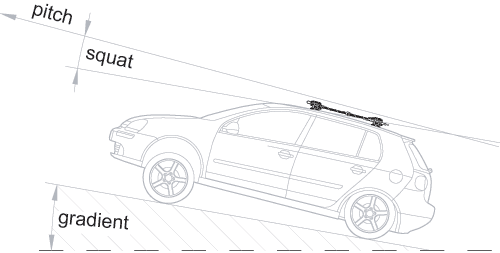What is the difference between gradient and pitch?
We define gradient as the vertical direction in which the vehicle is moving. This will generally be the same as the slope of the road. We define pitch as the vertical direction in which the vehicle (actually the antenna strip) is pointing. This may not be the same as the slope of the road since the vehicle may pitch during hard braking or acceleration.
Gradient (slope of the road) can be measured using either the SPEEDBOX or the SPEEDBOX-RTK. The SPEEDBOX can be configured to output a gradient message on either CAN, RS232, or on one of the analogue channels. This message contains gradient derived from integrated NED velocities, and is very accurate as long as the vehicle is moving. When the vehicle is stationary the velocities contain only noise, so the gradient is random and undefined.
The SPEEDBOX-RTK can also measure pitch (the angle in which the vehicle is pointing, assuming that the antenna's are mounted in the same plane as the vehicle, or the offset is known and accounted for). By subtracting the gradient from the pitch, the vehicle pitch angle relative to the road can be known. We call this the squat angle, and the SPEEDBOX-RTK can output squat as a message. Pitch is valid both when moving and stationary as long as the system has an RTK lock, squat is only valid when moving since it relies on gradient for it's calculation.
To summarise, to measure the slope of the road use the gradient message, but only when the vehicle is moving.
The following diagram shows the relationship between gradient, pitch and squat angles:

